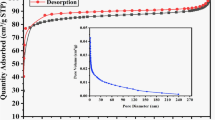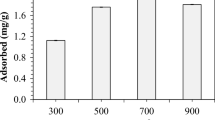Abstract
Biochar has been viewed as a cost-effective adsorptive material for heavy metals in water. In the present study, a total of nine different biochars synthesized from three different biomass types were studied: corn stover, organic peel, and pistachio shell at three pyrolysis temperatures (300, 450, and 600 °C). The efficiency of lead ion (Pb2+) removal by the biochars was investigated through batch adsorption experiments in parallel with physicochemical characterization of the biochars. Single-point Pb2+ adsorption at 10 mg L−1 showed that high-temperature corn stover biochar at 600 °C and low-temperature orange peel biochar at 300 °C performed the best in the Pb2+ removal (> 94%). Pistachio shell biochars were relatively poor at removing aqueous Pb2+ (20–35%). The efficiency of the Pb2+ removal increased with increasing pH (2–6) until a maximum adsorption of Pb2+ was observed at pH 6. Adsorption isotherms for Pb2+ were conducted using the best-performing biochars per biomass based on the single-point adsorption results. All isotherms were best described by the Langmuir model, and the Pb2+ sorption capacities were 25,000 mg kg−1 for corn stover biochar at 600 °C, 11,111 mg kg−1 for orange peel biochar at 300 °C, and 2500 mg kg−1 for pistachio shell at 600 °C. The physicochemical properties of biochars indicated that oxygen-containing functional groups and specific surface area were major parameters affecting aqueous Pb2+ removal. This study highlights that biomass type and pyrolysis temperature as well as solution pH are important in affecting the adsorption efficiency of Pb2+ from aqueous solution.






Similar content being viewed by others
References
Agrafioti E, Kalderis D, Diamadopoulos E (2014) Arsenic and chromium removal from water using biochars derived from rice husk, organic solid wastes and sewage sludge. J Environ Manag 133:309–314. https://doi.org/10.1016/j.jenvman.2013.12.007
Ahmad M, Rajapaksha AU, Lim JE et al (2014) Biochar as a sorbent for contaminant management in soil and water: a review. Chemosphere 99:19–33. https://doi.org/10.1016/j.chemosphere.2013.10.071
Bertocchi AF, Ghiani M, Peretti R, Zucca A (2006) Red mud and fly ash for remediation of mine sites contaminated with As, Cd, Cu, Pb and Zn. J Hazard Mater 134(1–3):112–119. https://doi.org/10.1016/j.jhazmat.2005.10.043
Cantrell KB, Hunt PG, Uchimiya M, Novak JM, Ro KS (2012) Impact of pyrolysis temperature and manure source on physicochemical characteristics of biochar. Bioresour Technol 107:419–428. https://doi.org/10.1016/j.biortech.2011.11.084
Chandler D, Roberson R (2009) Bioimaging: current concepts in light and electron microscopy. Jones and Bartlett International, London
Chen B, Chen Z (2009) Sorption of naphthalene and 1-naphthol by biochars of orange peels with different pyrolytic temperatures. Chemosphere 76:127–133. https://doi.org/10.1016/j.chemosphere.2009.02.004
Chen X, Chen G, Chen L, Chen Y, Lehmann J, McBride MB, Hay AG (2011) Adsorption of copper and zinc by biochars produced from pyrolysis of hardwood and corn straw in aqueous solution. Bioresour Technol 102(19):8877–8884. https://doi.org/10.1016/j.biortech.2011.06.078
Chen T, Zhang Y, Wang H, Lu W, Zhou Z, Zhang Y, Ren L (2014) Influence of pyrolysis temperature on characteristics and heavy metal adsorptive performance of biochar derived from municipal sewage sludge. Bioresour Technol 164:47–54. https://doi.org/10.1016/j.biortech.2014.04.048
Chun Y, Sheng G, Chiou CT, Xing B (2004) Compositions and sorptive properties of crop residue-derived chars. Environ Sci Technol 38(17):4649–4655. https://doi.org/10.1021/es035034w
Cui X, Fang S, Yao Y, Li T, Ni Q, Yang X, He Z (2016) Potential mechanisms of cadmium removal from aqueous solution by Canna indica derived biochar. Sci Total Environ 562:517–525. https://doi.org/10.1016/j.scitotenv.2016.03.248
Demirbas A (2008) Heavy metal adsorption onto agro-based waste materials: a review. J Hazard Mater 157(2–3):220–229. https://doi.org/10.1016/j.jhazmat.2008.01.024
Demirbas A, Gönenç A (2015) An overview of biomass pyrolysis. Energy Sources 24:471–482. https://doi.org/10.1080/00908310252889979
Ding W, Dong X, Ime IM, Gao B, Ma LQ (2014) Pyrolytic temperatures impact lead sorption mechanisms by bagasse biochars. Chemosphere 105:68–74. https://doi.org/10.1016/j.chemosphere.2013.12.042
Erdem E, Karapinar N, Donat R (2004) The removal of heavy metal cations by natural zeolites. J Colloid Interface Sci 280(2):309–314. https://doi.org/10.1016/j.jcis.2004.08.028
Essington ME (2015) Soil and water chemistry: an integrative approach. CRC Press, Boca Raton
Gupta VK, Rastogi A (2008) Biosorption of lead (II) from aqueous solutions by non-living algal biomass Oedogonium sp. and Nostoc sp.—a comparative study. Colloids Surf B Biointerfaces 64(2):170–178. https://doi.org/10.1016/j.colsurfb.2008.01.019
Higashikawa FS, Conz RF, Colzato M, Cerri CEP, Alleoni LRF (2016) Effects of feedstock type and slow pyrolysis temperature in the production of biochars on the removal of cadmium and nickel from water. J Clean Prod 137:965–972. https://doi.org/10.1016/j.jclepro.2016.07.205
International Biochar Initiative (2012) Standardized product definition and product testing guidelines for biochar that is used in soil. IBI biochar standards. https://www.biochar-international.org/wp-content/uploads/2018/04/IBI_Biochar_Standards_V2.1_Final.pdf. Accessed 16 Aug 2018
Inyang M, Gao B, Yao Y, Xue Y, Zimmerman AR, Pullammanappallil P, Cao X (2012) Removal of heavy metals from aqueous solution by biochars derived from anaerobically digested biomass. Bioresour Technol 110:50–56. https://doi.org/10.1016/j.biortech.2012.01.072
Ippolito JA, Spokas KA, Novak JM, Lentz RD, Cantrell KB (2015) Biochar elemental composition and factors influencing nutrient retention. In: Lehmann J, Joseph S (eds) Biochar for environmental management: science, technology and implementation. Routledge, New York, pp 139–164
Jin J, Li Y, Zhang J, Wu S et al (2016) Influence of pyrolysis temperature on properties and environmental safety of heavy metals in biochars derived from municipal sewage sludge. J Hazard Mater 320:417–426. https://doi.org/10.1016/j.jhazmat.2016.08.050
Jindo K, Mizumoto H, Sawada Y, Sanchez-Monedero MA, Sonoki T (2014) Physical and chemical characterization of biochars derived from different agricultural residues. Biogeosciences 11(23):6613–6621. https://doi.org/10.5194/bg-11-6613-2014
Keiluweit M, Nico PS, Johnson MG, Kleber M (2010) Dynamic molecular structure of plant biomass-derived black carbon (biochar). Environ Sci Technol 44(4):1247–1253. https://doi.org/10.1021/es9031419
Kim KH, Kim JY, Cho TS, Choi JW (2012) Influence of pyrolysis temperature on physicochemical properties of biochar obtained from the fast pyrolysis of pitch pine (Pinus rigida). Bioresour Technol 118:158–162. https://doi.org/10.1016/j.biortech.2012.04.094
Komnitsas K, Zaharaki D, Pyliotis I, Vamvuka D, Bartzas G (2015) Assessment of pistachio shell biochar quality and its potential for adsorption of heavy metals. Waste Biomass Valorization 6(5):805–816. https://doi.org/10.1007/s12649-015-9364-5
Lehmann J (2007) A handful of carbon. Nature 447(7141):143. https://doi.org/10.1038/447143a
Li F, Shen K, Long X et al (2016) Preparation and characterization of biochars from Eichornia crassipes for cadmium removal in aqueous solutions. PLoS ONE 11(2):e0148132. https://doi.org/10.1371/journal.pone.0148132
Liu Z, Zhang FS (2009) Removal of lead from water using biochars prepared from hydrothermal liquefaction of biomass. J Hazard Mater 167(1–3):933–939. https://doi.org/10.1016/j.jhazmat.2009.01.085
Lo W, Chua H, Lam KH, Bi SP (1999) A comparative investigation on the biosorption of lead by filamentous fungal biomass. Chemosphere 39(15):2723–2736. https://doi.org/10.1016/S0045-6535(99)00206-4
Ma X, Zhou B, Budai A et al (2016) Study of biochar properties by scanning electron microscope-energy dispersive X-ray spectroscopy (SEM-EDX). Commun Soil Sci Plant Anal 47(5):593–601. https://doi.org/10.1080/00103624.2016.1146742
Mary GS, Sugumaran P, Niveditha S et al (2016) Production, characterization and evaluation of biochar from pod (Pisum sativum), leaf (Brassica oleracea) and peel (Citrus sinensis) wastes. Int J Recycl Org waste Agric 5:43–53. https://doi.org/10.1007/s40093-016-0116-8
Mireles S, Ok Y, Cheng C, Kang J (2016) Adsorptive and kinetic characterization of aqueous zinc removal by biochars. SDRP J Earth Sci Environ Stud 1(3):1–7. https://doi.org/10.15436/JESES.1.3.2
Mukome FN, Parikh SJ (2015) Chemical, physical, and surface characterization of biochar. In: Ok YS (ed) Biochar: production, characterization, and applications. CRC Press, Boca Raton, pp 68–96
Naushad M, Vasudevan S, Sharma G, Kumar A, ALOthman ZA, Alshehri SM, Ghfar AA (2016) Synthesis and characterization of a new starch/SnO2 nanocomposite for efficient adsorption of toxic Hg2+ metal ion. Chem Eng J 300:306–316. https://doi.org/10.1016/j.cej.2016.04.084
Niu L, Deng S, Yu G, Huang J (2010) Efficient removal of Cu(II), Pb(II), Cr(VI) and As(V) from aqueous solution using an aminated resin prepared by surface-initiated atom transfer radical polymerization. Chem Eng J 165(3):751–757. https://doi.org/10.1016/j.cej.2010.08.053
Novak JM, Lima I, Xing B et al (2009) Characterization of designer biochar produced at different temperatures and their effects on a loamy sand. Ann Environ Sci 3:195–206
Rafiq MK, Bachmann RT, Rafiq MT, Shang Z, Joseph S, Long R (2016) Influence of pyrolysis temperature on physico-chemical properties of corn stover (Zea mays L.) biochar and feasibility for carbon capture and energy balance. PLoS ONE 11(6):e0156894. https://doi.org/10.1371/journal.pone.0156894
Rehrah D, Reddy MR, Novak JM et al (2014) Production and characterization of biochars from agricultural by-products for use in soil quality enhancement. J Anal Appl Pyrolysis 108:301–309. https://doi.org/10.1016/j.jaap.2014.03.008
Saeed A, Akhter MW, Iqbal M (2005) Removal and recovery of heavy metals from aqueous solution using papaya wood as a new biosorbent. Sep Purif Technol 45(1):25–31. https://doi.org/10.1016/j.seppur.2005.02.004
Samsuri AW, Sadegh-Zadeh F, Seh-Bardan BJ (2013) Adsorption of As (III) and As (V) by Fe coated biochars and biochars produced from empty fruit bunch and rice husk. J Environ Chem Eng 1(4):981–988. https://doi.org/10.1016/j.jece.2013.08.009
Tan X, Liu Y, Zeng G, Wang X, Hu X, Gu Y, Yang Z (2015) Application of biochar for the removal of pollutants from aqueous solutions. Chemosphere 125:70–85. https://doi.org/10.1016/j.chemosphere.2014.12.058
Tran HN, You SJ, Chao HP (2016) Effect of pyrolysis temperatures and times on the adsorption of cadmium onto orange peel derived biochar. Waste Manag Res 34(2):129–138. https://doi.org/10.1177/0734242X15615698
Uchimiya M, Wartelle LH, Klasson KT, Fortier CA, Lima IM (2011) Influence of pyrolysis temperature on biochar property and function as a heavy metal sorbent in soil. J Agric Food Chem 59(6):2501–2510. https://doi.org/10.1021/jf104206c
Van der Perk M (2013) Soil and water contamination. CRC Press, Boca Raton
Xu D, Zhao Y, Sun K et al (2014) Cadmium adsorption on plant-and manure-derived biochar and biochar-amended sandy soils: impact of bulk and surface properties. Chemosphere 111:320–326. https://doi.org/10.1016/j.chemosphere.2014.04.043
Yang H, Yan R, Chen H, Lee DH, Zheng C (2007) Characteristics of hemicellulose, cellulose and lignin pyrolysis. Fuel 86(12–13):1781–1788. https://doi.org/10.1016/j.fuel.2006.12.013
Yap MW, Mubarak NM, Sahu JN, Abdullah EC (2017) Microwave induced synthesis of magnetic biochar from agricultural biomass for removal of lead and cadmium from wastewater. J Ind Eng Chem 45:287–295. https://doi.org/10.1016/j.jiec.2016.09.036
Yin J, Deng C, Yu Z, Wang X (2018) Effective removal of lead ions from aqueous solution using nano illite/smectite clay: isotherm, kinetic, and thermodynamic modeling of adsorption. Water 10(2):210. https://doi.org/10.3390/w10020210
Yuan JH, Xu RK, Zhang H (2011) The forms of alkalis in the biochar produced from crop residues at different temperatures. Bioresour Technol 102(3):3488–3497. https://doi.org/10.1016/j.biortech.2010.11.018
Zama EF, Zhu YG, Reid BJ, Sun GX (2017) The role of biochar properties in influencing the sorption and desorption of Pb(II), Cd(II) and As(III) in aqueous solution. J Clean Prod 148:127–136. https://doi.org/10.1016/j.jclepro.2017.01.125
Zheng H, Wang Z, Zhao J, Herbert S, Xing B (2013) Sorption of antibiotic sulfamethoxazole varies with biochars produced at different temperatures. Environ Pollut 181:60–67. https://doi.org/10.1016/j.envpol.2013.05.056
Acknowledgements
Funding was provided by faculty startup for Kang and a graduate assistantship from the University of Texas Rio Grand Valley. We like to thank Thomas Eubanks for his help with SEM–EDX analyses. We also thank anonymous reviewers for their valuable comments and suggestions on the manuscript.
Author information
Authors and Affiliations
Corresponding author
Additional information
Editorial responsibility: Gaurav Sharma.
Rights and permissions
About this article
Cite this article
Mireles, S., Parsons, J., Trad, T. et al. Lead removal from aqueous solutions using biochars derived from corn stover, orange peel, and pistachio shell. Int. J. Environ. Sci. Technol. 16, 5817–5826 (2019). https://doi.org/10.1007/s13762-018-02191-5
Received:
Revised:
Accepted:
Published:
Issue Date:
DOI: https://doi.org/10.1007/s13762-018-02191-5




